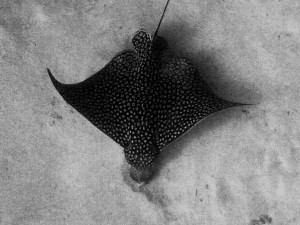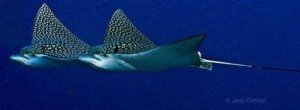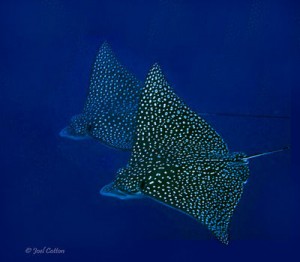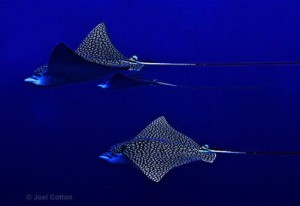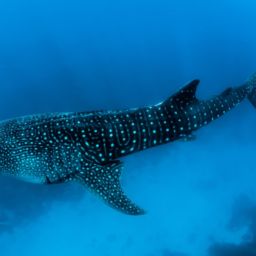It can be 30 seconds or 30 minutes before it happens, but it’s so worth the wait! Ten minutes passed by without any action and I could see that some divers were getting restless and losing hope, but I knew it would happen, it always does, this place is not called Eagle Ray Pass for nothing… My faith was immediately gratified: four… seven… ten… sixteen (!!!) eagle rays appeared literally out of the blue, effortlessly gliding against the current in their squadron-like formation. It didn’t seem like they were moving their powerful wings at all, and yet it took them only a couple of minutes to completely disappear from our view field. But ten seconds later they turned back and passed in the other direction. And another time. And then another time. They always do that here for some reason. Maybe this site is there training ground… I am mesmerized by these amazing creatures, their pre-historic beauty awakening something very primal in me. We try to breathe as slowly as possible to extend this deep encounter, but our gauges are ruthless, and so are our computers that start flashing the no-decompression limit at us, beeping in panic. “Fine, – I can almost hear each person sigh in desperation. – “We have to ascend.”
This is my favorite dive and when the winter comes I’m ready to go North every day to hang out motionlessly at Cantarel and admire eagle rays. Sometimes there are 30 of them together, sometimes only 2 (people say that sometimes none appears, but I personally have been lucky every dive) – no matter how many you see, it’s always a powerful and fascinating view.
On occasion, you can see eagle rays in Cozumel year around, but the winter and early spring – their breeding season – bring a lot of them here, and if you are like me, you may want to consider spending all your dive time on the north side of the island, fighting waves and currents for an unforgettable meeting.
Species
The eagle rays are a group of cartilaginous fishes in the family Myliobatidae, consisting mostly of large species living in the open ocean rather than on the sea bottom. They were originally described in 1790 as Raja narinari (Euphrasen 1790). The name was changed to Stoasodon narinari and later to the currently valid name Aetobatus narinari (aetos meaning “eagle” and batismeaning “ray” in Greek).
Habitat
The spotted eagle ray is distributed worldwide in tropical and warm temperate waters: western Atlantic Ocean, Gulf of Mexico, Caribbean, Indo-West Pacific,ReadSeaandPacific Ocean.
Eagle rays are commonly observed in bays and over coral reefs as well as the occasional foray into estuarine habitats. They spend most of their time swimming in schools in open water and when pursued can leap completely out of the water. They are known to be site loyal (often stay or return to the same location) and pretty social within their own species.
Diet
Eagle rays prey on clams, oysters, shrimp, octopus, squid and sea urchins, as well as some bony fishes. They are well equipped with a shovel-shaped snout and duck-like bill for searching in the mud for benthic invertebrates.
Threats
In turn, eagle rays serve as prey for various sharks, including the silvertip shark and great hammerhead. The predators are also known to follow eagle rays during the birthing time to feed on the pups.
Reproduction
Eagle rays are ovoviparous: they develop eggs inside the body and hatch them within. Instead of a placental connection with the mother, the hatched embryos are nourished by a yolk sac. Each litter contains about 4 pups, 7-14 inches big.
Sources: Wikipedia
Ichthyology


